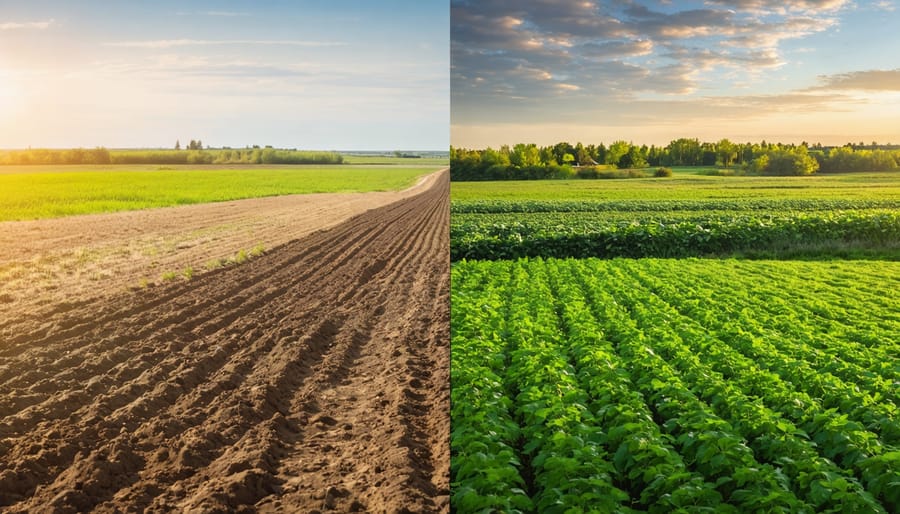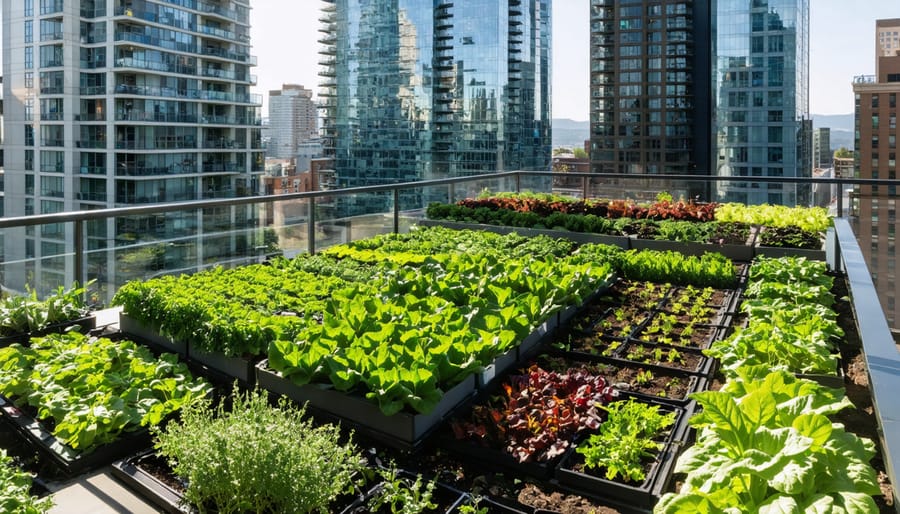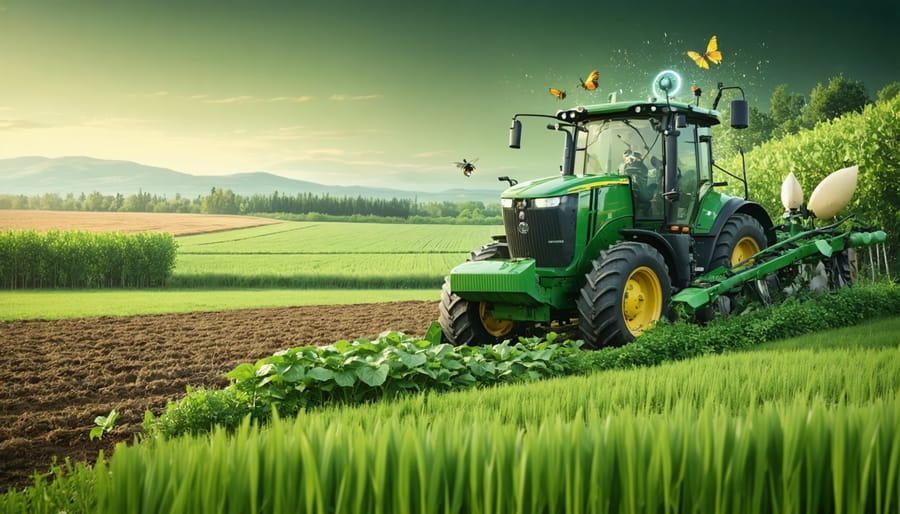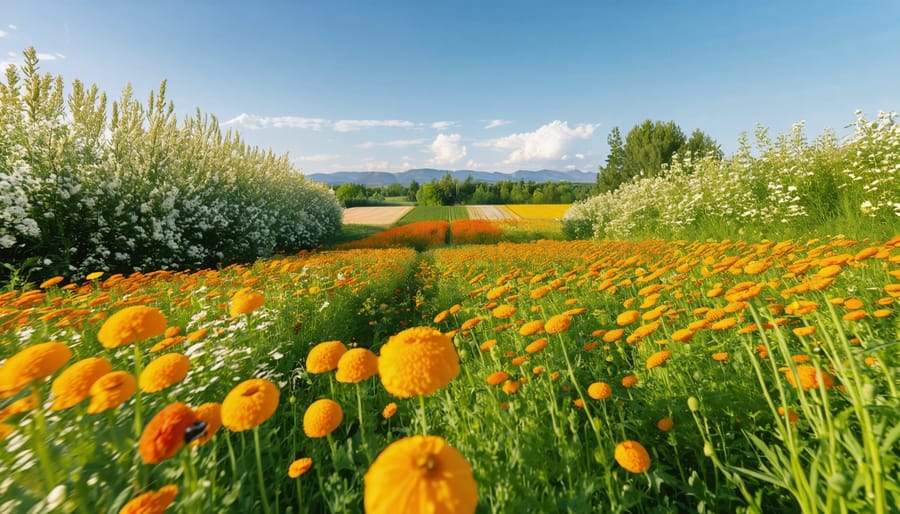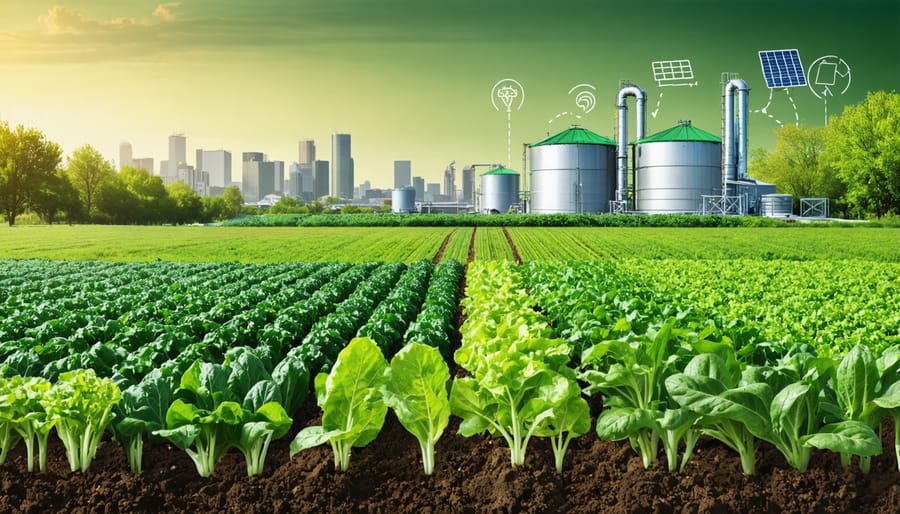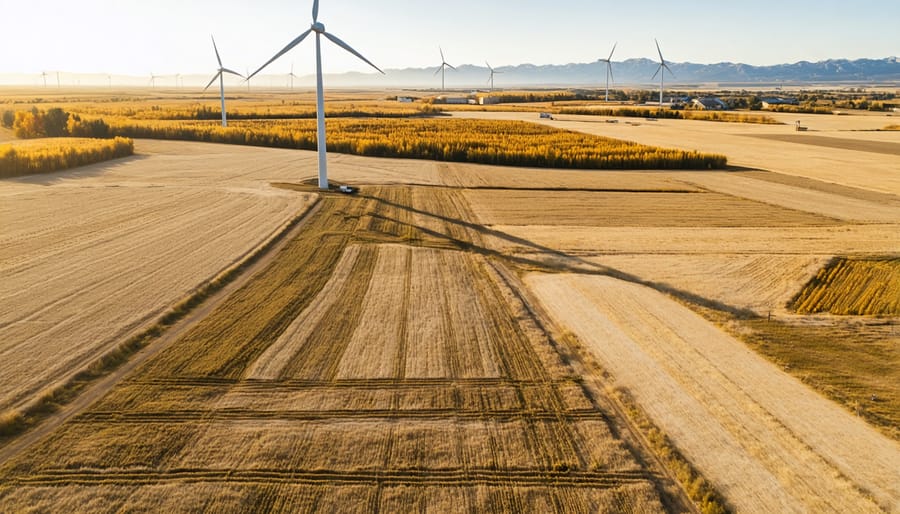As Alberta’s agricultural landscape evolves, regenerative farming and permaculture emerge as two transformative approaches reshaping how we cultivate our prairies. While both methods prioritize soil health and ecosystem restoration, they differ fundamentally in their scope and implementation. Regenerative farming focuses on large-scale agricultural practices that rebuild soil organic matter and restore degraded biodiversity, employing techniques like cover cropping and rotational grazing across existing farmland. Permaculture, meanwhile, takes a holistic design approach, creating self-sustaining food systems that mimic natural ecosystems, often on smaller parcels.
For Alberta farmers navigating between these methods, understanding their distinct advantages becomes crucial. Regenerative practices have shown remarkable success in our province’s grain belt, with some operations reporting 40% reduction in input costs while maintaining yields. Permaculture systems, though typically smaller in scale, demonstrate exceptional resilience during our extreme weather events, with integrated water management systems proving particularly valuable during drought periods.
The choice between these approaches isn’t binary – many successful Alberta operations integrate elements of both. This hybrid approach allows farmers to maintain commercial viability while gradually transitioning toward more sustainable practices, addressing both immediate economic needs and long-term environmental stewardship. As our agricultural sector faces mounting challenges from climate change and market pressures, these complementary methods offer practical solutions for building resilient, profitable farming operations.
The Core Principles That Define Each Approach
Regenerative Farming’s Focus on Soil Health
At the heart of regenerative organic agriculture lies a fundamental focus on soil health as the cornerstone of sustainable farming. Unlike conventional farming methods that often deplete soil resources, regenerative practices actively work to build soil organic matter and restore degraded land.
Here in Alberta, farmers implementing regenerative techniques have reported significant improvements in their soil structure and fertility. These improvements come through practices like minimal tillage, cover cropping, and planned grazing patterns that mimic natural ecosystems. The emphasis on soil biodiversity helps create resilient farming systems that can better withstand our prairie climate extremes.
Carbon sequestration is another crucial benefit of regenerative farming’s soil-first approach. Through photosynthesis and improved soil management, these practices help pull carbon dioxide from the atmosphere and store it in the soil. Local studies show that Alberta farms using regenerative methods can sequester between 0.3 to 2 tonnes of carbon per hectare annually.
The focus on soil health also leads to better water retention, reduced erosion, and decreased dependence on synthetic inputs. Many Alberta farmers report using up to 50% less irrigation after several years of regenerative practices, while maintaining or improving their yields. This approach not only benefits the environment but also contributes to the long-term economic sustainability of farm operations.

Permaculture’s Whole Systems Design
At the heart of permaculture lies a sophisticated yet natural approach to farm design that views agricultural spaces as interconnected ecosystems. Unlike conventional farming methods, permaculture embraces permaculture principles that mirror nature’s own patterns and relationships.
Here in Alberta, successful permaculture designs integrate local climate considerations, incorporating features like windbreaks and water-harvesting systems that work harmoniously with our prairie environment. These systems typically include multiple layers of production, from root crops and ground covers to shrubs and tree canopies, creating a food forest that maximizes both vertical and horizontal space.
The design process begins with careful observation of land patterns, water flow, and existing biodiversity. Each element serves multiple functions – for instance, a pond provides irrigation, creates habitat for beneficial insects, and helps moderate temperature extremes. Similarly, carefully positioned livestock contribute to pest management, soil fertility, and vegetation control while producing food.
What sets permaculture apart is its emphasis on connections rather than individual components. For example, placing chicken coops near garden areas allows for natural pest control and fertilization, while strategic placement of evergreens provides winter shelter for both livestock and tender plants. This integrated approach reduces the need for external inputs while building resilience into the farming system.
For Canadian farmers, this whole-systems approach offers practical solutions for challenges like short growing seasons and extreme temperature fluctuations, while creating sustainable, productive landscapes that improve over time.
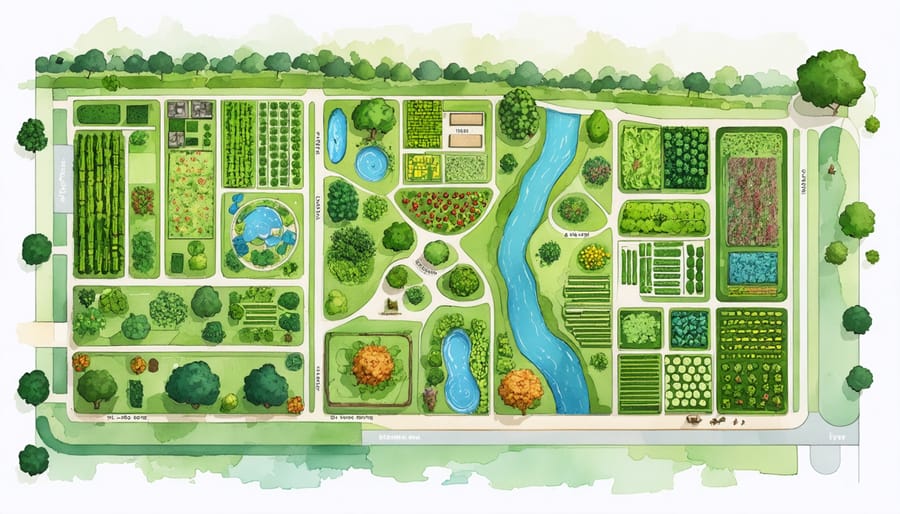
Real Results from Alberta Farms

Success Stories in Regenerative Agriculture
Meet John Anderson, a third-generation farmer from Lacombe County, who transformed his 2,000-hectare grain operation through regenerative practices. “Five years ago, our soil organic matter was barely 2%. Today, we’re measuring 4.5% across our fields,” Anderson shares. By implementing no-till practices and diverse cover crops, he’s reduced his fertilizer inputs by 30% while maintaining yields.
Sarah Mitchell, who runs a mixed farming operation near Camrose, tells a similar story. “We started with rotational grazing in 2018, moving our cattle daily during the growing season. The transformation in our pastures has been remarkable,” she explains. Mitchell’s water retention has improved significantly, and she estimates saving $40,000 annually on feed costs.
In the Peace Country region, Tom and Marie Wilson have successfully integrated regenerative practices on their 400-hectare farm. “Our biggest win has been biodiversity,” Marie notes. “We’ve documented 23 bird species that weren’t here before, and our beneficial insect population has exploded.” The Wilsons credit their success to maintaining living roots in the soil year-round and minimizing soil disturbance.
Near Lethbridge, Christine Wong has adapted regenerative principles to address drought conditions. “By implementing windbreaks and practicing continuous soil coverage, we’ve reduced water usage by 25%,” Wong reports. Her operation now serves as a demonstration site for local farmers interested in regenerative transitions.
These success stories share common themes: improved soil health, reduced input costs, and enhanced resilience to weather extremes. Each farmer emphasizes the importance of starting small, observing results, and gradually expanding successful practices. Their experiences prove that regenerative agriculture can work effectively within Alberta’s diverse agricultural landscapes, offering both environmental and economic benefits to producers willing to make the transition.
Permaculture Projects That Work
Several thriving permaculture projects across Alberta demonstrate how these principles can succeed in our challenging climate. The Urban Farm at Olds College has become a prime example of permaculture success, featuring food forests that combine fruit trees, berry bushes, and medicinal herbs in a self-sustaining ecosystem that requires minimal maintenance once established.
In the Edmonton area, the Prairie Urban Farm showcases how permaculture design can transform conventional agricultural spaces into diverse food production systems. Their innovative water management system, which includes swales and rain gardens, has reduced irrigation needs by 40% while improving soil moisture retention throughout the growing season.
The Paintearth Community Garden in east-central Alberta demonstrates how permaculture principles can build community resilience. Their guild-planting approach, combining indigenous plants with traditional crops, has created a productive space that withstands both drought and early frost conditions. The project produces an average of 2,000 kg of food annually while serving as an educational hub for local residents.
Near Calgary, the Root Cellar Farm has successfully implemented a food forest system that includes cold-hardy fruit trees, nitrogen-fixing plants, and perennial vegetables. Their careful species selection and strategic placement have created microclimates that extend the growing season by up to three weeks on either end.
These projects share common success factors: thorough site analysis, careful species selection suited to Zone 3-4 conditions, and strong community engagement. Most notably, they’ve all incorporated traditional Indigenous knowledge about local ecosystems, demonstrating how ancient wisdom can enhance modern permaculture practices.
Small-scale experiments have shown that even backyard permaculture systems can yield significant results. One Red Deer resident’s 400-square-metre lot produces enough food to supply 70% of their family’s produce needs through strategic vertical growing and season extension techniques.
Economic Impacts and Implementation Costs
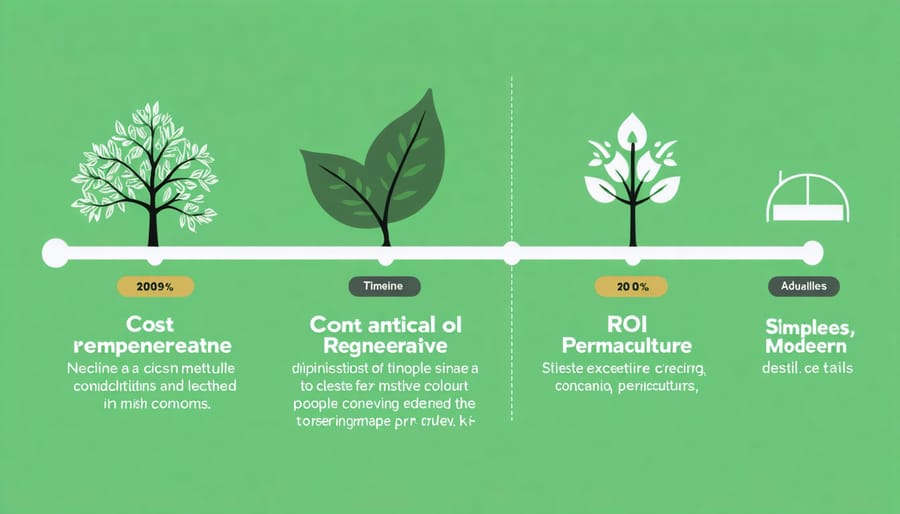
Initial Investment Requirements
Starting a regenerative farming or permaculture project requires careful financial planning and resource allocation. For regenerative farming in Alberta, initial investments typically range from $500 to $1,500 per acre, depending on existing infrastructure and soil conditions. Key startup costs include soil testing ($150-300 per field), cover crop seeds ($50-150 per acre), and potentially new equipment for minimum tillage practices ($15,000-50,000).
Permaculture setups generally require lower initial capital, averaging $200-800 per acre, but demand more intensive design work upfront. Essential investments include permaculture design courses ($1,500-2,500), plant materials ($300-1,000 for initial perennials), and water management systems ($2,000-5,000).
Both approaches can benefit from government grants and support programs. The Canadian Agricultural Partnership offers funding for sustainable agriculture initiatives, potentially covering up to 30% of eligible costs. Local conservation authorities often provide additional support through cost-sharing programs.
Resource needs differ significantly. Regenerative farming typically requires:
– Traditional farm equipment (modified for low-till practices)
– Annual seed inventory
– Soil amendments
– Labour for seasonal operations
Permaculture focuses on:
– Design tools and materials
– Perennial plants and trees
– Water harvesting equipment
– Initial landscape modification tools
Many Alberta farmers have found success by starting small and scaling up gradually, allowing for learning and adaptation while managing costs effectively. Consider joining local farming networks to share resources and reduce initial expenses through equipment-sharing arrangements.
Long-term Financial Benefits
When comparing the long-term financial benefits of both approaches, it’s essential to consider how sustainable farming practices impact your bottom line. While both methods require initial investments, they offer distinct economic advantages over conventional farming.
Regenerative farming typically shows faster returns on investment, with many Alberta farmers reporting reduced input costs within 2-3 growing seasons. The primary savings come from decreased reliance on synthetic fertilizers and pesticides, with soil improvement leading to better water retention and reduced irrigation needs. Local case studies show operational cost reductions of 25-40% after five years of implementation.
Permaculture systems, while requiring more upfront planning and investment, often deliver more diverse revenue streams. Many successful Alberta permaculture operations report income from multiple sources: traditional crops, specialty foods, value-added products, and educational programs. These systems typically become profitable within 4-5 years, with some farmers reporting gross margins increasing by 60% compared to conventional methods.
Both approaches significantly reduce long-term equipment costs and fuel consumption. They also build resilience against market fluctuations through diversified income sources and improved soil health, which maintains productivity during challenging weather conditions. The key to maximizing returns is selecting the approach that best matches your land’s characteristics and your operation’s goals.
Integration Strategies for Alberta Farms
Creating a Hybrid Approach
Creating a balanced hybrid approach between regenerative farming and permaculture can maximize the benefits of both methodologies while addressing Alberta’s unique agricultural challenges. Here’s how to effectively blend these practices:
Start by conducting a thorough assessment of your land, considering soil composition, water resources, and local climate patterns. This baseline information will help determine which elements from each approach will work best for your situation.
Begin with these foundational steps:
1. Implement no-till or minimal-till practices from regenerative agriculture while incorporating permaculture’s zone planning for efficient land use.
2. Establish windbreaks using permaculture’s food forest concepts, which also support regenerative farming’s emphasis on soil protection.
3. Design water management systems that combine permaculture’s water harvesting techniques with regenerative farming’s focus on soil moisture retention.
4. Integrate livestock using managed grazing patterns that build soil health while maintaining permanent cultivation areas typical in permaculture designs.
Many Alberta farmers have found success by:
– Using cover crops that serve multiple functions
– Creating beneficial insect habitats within production areas
– Establishing perennial food systems alongside annual crops
– Implementing rotational grazing that mimics natural patterns
Local farmer Mike Thompson from Red Deer shares, “We’ve seen remarkable improvements in soil health and crop resilience by combining these approaches. Our yields have stabilized, and we’re using less inputs overall.”
Remember to start small and scale up gradually. Choose one field or section of your property to experiment with these hybrid techniques before expanding. Monitor results carefully and adjust your approach based on what works best in your specific context.
Consider joining local farming networks or study groups to share experiences and learn from others who are successfully blending these methods. The Alberta Regenerative Farming Network and regional permaculture groups offer valuable support and knowledge-sharing opportunities.
Adapting to Local Conditions
Alberta’s unique agricultural landscape demands thoughtful adaptation of both regenerative farming and permaculture practices. Our province’s distinct challenges, including short growing seasons, variable precipitation, and extreme temperature fluctuations, require careful consideration when implementing these sustainable approaches. Successful implementation of climate solutions for Alberta farms often involves combining elements from both methodologies.
For the southern prairies, focus on drought-resistant crop selection and water conservation techniques. Consider implementing windbreaks and shelterbelts using native species like wolf willow and saskatoon bushes, which serve multiple purposes in both systems. In central Alberta’s parkland region, emphasis should be placed on soil building techniques that work with spring moisture patterns and protect against summer drought.
Northern regions benefit from cold-hardy perennial integration and season extension strategies. Greenhouse cultivation and passive solar design principles from permaculture can extend growing seasons by up to six weeks. Creating microclimates using landform modifications helps protect sensitive crops while maximizing available sunlight.
Soil composition varies significantly across Alberta, from heavy clay to sandy loam. Adapt your soil building approach accordingly:
– For clay soils: Focus on organic matter incorporation and cover cropping to improve structure
– For sandy soils: Emphasize water retention strategies and frequent application of compost
– For loamy soils: Maintain soil health through diverse crop rotations and minimal tillage
Monitor your local frost patterns, precipitation cycles, and wind conditions to fine-tune your implementation strategy. Start small with test plots to evaluate which techniques work best for your specific location. Connect with local farming networks to share experiences and learn from others who have successfully adapted these practices to similar conditions.
Remember that successful adaptation often requires patience and observation over several growing seasons. Document your results and adjust your approach based on what works best in your specific microclimate.
As we’ve explored throughout this article, both regenerative farming and permaculture offer valuable approaches to sustainable agriculture in Alberta. While they share common ground in their focus on soil health and ecosystem restoration, each method provides unique benefits that can be adapted to your specific farming context.
For those ready to take the next step, we recommend starting small with a pilot project on a portion of your land. Begin by conducting a thorough soil analysis and documenting your current practices. Consider joining local farming networks or attending workshops offered through Alberta’s agricultural extension services to connect with experienced practitioners.
If you’re drawn to regenerative farming, focus initially on implementing no-till practices and introducing cover crops suitable for our climate. For those interested in permaculture, start by mapping your land’s natural patterns and establishing windbreaks or food forests on a manageable scale.
Remember that transition takes time, and success looks different for every farm. Many Alberta farmers have found that combining elements from both approaches yields the best results for their operations. The key is to remain flexible and adjust your methods based on your land’s response and your operational goals.
Support is available through various channels, including local agricultural societies, government programs, and mentor networks. Consider reaching out to the growing community of regenerative and permaculture farmers in Alberta who are often eager to share their experiences and lessons learned.
By taking thoughtful steps toward either or both of these approaches, you’re contributing to a more resilient agricultural future for Alberta while potentially improving your farm’s productivity and profitability.

